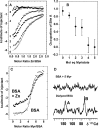A molecular mechanism for modulating plasma Zn speciation by fatty acids
- PMID: 22239162
- PMCID: PMC3285120
- DOI: 10.1021/ja210496n
A molecular mechanism for modulating plasma Zn speciation by fatty acids
Abstract
Albumin transports both fatty acids and zinc in plasma. Competitive binding studied by isothermal titration calorimetry revealed that physiologically relevant levels of fatty acids modulate the Zn-binding capacity of albumin, with far-reaching implications for biological zinc speciation. The molecular mechanism for this effect is likely due to a large conformational change elicited by fatty acid binding to a high-affinity interdomain site that disrupts at least one Zn site. Albumin may be a molecular device to "translate" certain aspects of the organismal energy state into global zinc signals.
© 2012 American Chemical Society
Figures





Similar articles
-
Allosteric modulation of zinc speciation by fatty acids.Biochim Biophys Acta. 2013 Dec;1830(12):5456-64. doi: 10.1016/j.bbagen.2013.05.028. Epub 2013 May 29. Biochim Biophys Acta. 2013. PMID: 23726993 Review.
-
Plasma free fatty acid levels influence Zn(2+) -dependent histidine-rich glycoprotein-heparin interactions via an allosteric switch on serum albumin.J Thromb Haemost. 2015 Jan;13(1):101-10. doi: 10.1111/jth.12771. Epub 2014 Nov 22. J Thromb Haemost. 2015. PMID: 25353308 Free PMC article.
-
A metalloproteomic analysis of interactions between plasma proteins and zinc: elevated fatty acid levels affect zinc distribution.Metallomics. 2019 Nov 1;11(11):1805-1819. doi: 10.1039/c9mt00177h. Epub 2019 Oct 15. Metallomics. 2019. PMID: 31612889
-
Targeted removal of the FA2 site on human albumin prevents fatty acid-mediated inhibition of Zn2+ binding.J Lipid Res. 2024 Jun;65(6):100560. doi: 10.1016/j.jlr.2024.100560. Epub 2024 May 14. J Lipid Res. 2024. PMID: 38750995 Free PMC article.
-
Crosstalk between zinc and free fatty acids in plasma.Biochim Biophys Acta Mol Cell Biol Lipids. 2019 Apr;1864(4):532-542. doi: 10.1016/j.bbalip.2018.09.007. Epub 2018 Sep 25. Biochim Biophys Acta Mol Cell Biol Lipids. 2019. PMID: 30266430 Free PMC article. Review.
Cited by
-
Zinc in Prostate Health and Disease: A Mini Review.Biomedicines. 2022 Dec 10;10(12):3206. doi: 10.3390/biomedicines10123206. Biomedicines. 2022. PMID: 36551962 Free PMC article. Review.
-
Albumin Substitution in Decompensated Liver Cirrhosis: Don't Forget Zinc.Nutrients. 2021 Nov 10;13(11):4011. doi: 10.3390/nu13114011. Nutrients. 2021. PMID: 34836265 Free PMC article. Review.
-
Association between Serum Zinc and Calcification Propensity (T50) in Patients with Type 2 Diabetes Mellitus and In Vitro Effect of Exogenous Zinc on T50.Biomedicines. 2020 Sep 9;8(9):337. doi: 10.3390/biomedicines8090337. Biomedicines. 2020. PMID: 32916995 Free PMC article.
-
Structural and biochemical characterisation of Co2+-binding sites on serum albumins and their interplay with fatty acids.Chem Sci. 2023 May 23;14(23):6244-6258. doi: 10.1039/d3sc01723k. eCollection 2023 Jun 14. Chem Sci. 2023. PMID: 37325156 Free PMC article.
-
Ischemia-modified albumin: Crosstalk between fatty acid and cobalt binding.Prostaglandins Leukot Essent Fatty Acids. 2018 Aug;135:147-157. doi: 10.1016/j.plefa.2018.07.014. Epub 2018 Jul 20. Prostaglandins Leukot Essent Fatty Acids. 2018. PMID: 30103926 Free PMC article. Review.
References
Publication types
MeSH terms
Substances
Grants and funding
LinkOut - more resources
Full Text Sources

